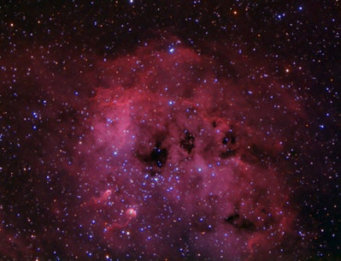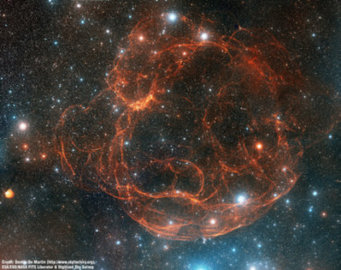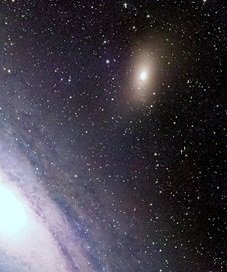Milky Way Trail
1) IC 410

We start our journey in the outer rims of our Milky Way galaxy. IC 410 is a cluster in the constellation Auriga (the charioteer), enclosed by a gaseous nebula still forming new stars. From here it takes 15,000 light years (scaled: 1.5 km) to the Earth and 40,000 light years (scaled: 4 km) to the centre of our Milky Way. At normal speed (4 km/h) the full walk will take about one hour, walking in scale at 350 million times the speed of light!
2) h and Chi Persei
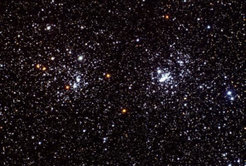
h and Chi Persei (also NGC 869 and NGC 884) form a beautiful double cluster which may be visible with the naked eye under good seeing conditions and provides an extraordinary view with a pair of binoculars.
From the start we have walked 7,000 light years (scaled 700 metres) and it takes another 8,000 light years (800 metres) to reach the Earth.
3) Crab Nebula
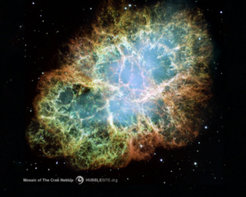
The Crab Nebula (also Messier 1 or M1) in the constellation Taurus (the bull) is the remnant of a supernova explosion that took place in the year 1054. A supernova marks the final stage in the life of a massive star, becoming a million to a billion times brighter than before. For a couple of days the star can shine as brightly as a whole galaxy. A filamentary nebula in visible light, this is the fourth-strongest radio source in the sky with a pulsar, a rapidly rotating neutron star, in its centre. The Crab pulsar rotates 30 times per second around its axis!
From the start we have walked 8,700 light years (scaled 870 metres) and it takes another 6,300 light years (630 metres) to reach the Earth.
4) S147

S147 (Simeis 147) at the border between the two constellations Gemini (the twins) and Auriga (the charioteer) is an old and very extended supernova remnant where the supernova explosion took place more than a 100,000 years ago. With a total extent of three degrees (or six times the diameter of the full moon in the sky) it is very extended, but also very low in surface brightness.
From the start we have walked 12,000 light years (scaled 1.2 kilometres) and it takes another 3,000 light years (300 metres) to reach the Earth.
5) Orion Nebula
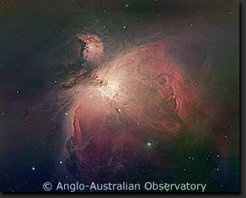
The Orion Nebula (M42) is a star forming region which can be spotted with the naked eye in a clear winter night below the three bright stars forming Orion’s belt.
From the start we have walked 13,500 light years (scaled 1.35 kilometres) and it takes another 1,500 light years (150 metres) to reach the Earth.
6) Betelgeuse
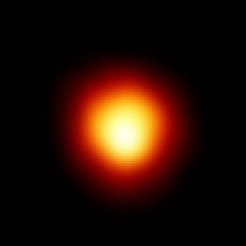
The bright star Betelgeuse (or Beteigeuze in German) forms the left shoulder of Orion, the Great Hunter in the sky. It is a red super giant star with almost 500 times the diameter of our sun. Betelgeuse is a candidate for a supernova explosion even in the near future. At maximum brightness the supernova would show up as bright as the moon for a couple of days.
From the start we have walked 14,570 light years (scaled 1.46 kilometres) and it takes another 430 light years (43 metres) to reach the Earth.
7) Pleiades
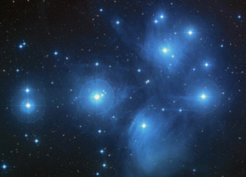
The Pleiades ("Seven Sisters“) in the constellation of Taurus (the bull) present the most beautiful stellar cluster in the sky. They can easily be found by extending the three stars of Orion’s belt to the right, and between six and eight stars can usually be separated with the naked eye.
From the start we have walked 14,600 light years (scaled 1.46 kilometres) and it takes another 400 light years (40 metres) to reach the Earth.
8) Sirius
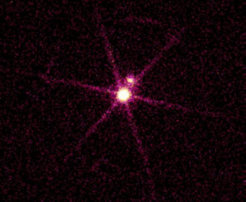
Sirius in the constellation Canis Major (the great dog) is the brightest star in the whole sky. The identification is easily done by extending Orion’s belt to the left. Sirius is a binary star with a very dense white dwarf star ("Sirius B“) as companion. On the scale of the Planetary Walk, Sirius is 11,000 kilometers away from the Earth at the APEX radio telescope in Chile, on the scale of the Milky Way Walk that shrinks to a mere 90 cm.
From the start we have walked 14,991 light years (scaled 1.5 kilometres) and it takes another 9 light years (90 centimetres) to reach the Earth.
9) The Sun/The Earth
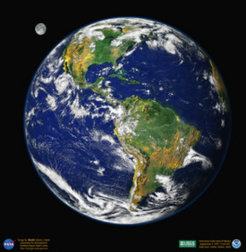
Walking 15,000 light years (or 1.5 km) we have reached our solar system with the Sun and the Earth. On the scale of the Planetary Walk (1 : 7.7 billion), the distance between the sun and the dwarf planet Pluto is 766 metres. On the Milky Way Walk (1 : 100 quadrillions), the same distance scales to 60 nanometers only, corresponding to the diameter of a virus.
From the Earth it takes another 25,000 light years (2.5 kilometres) to reach the centre of our Milky Way.
10) Alpha Centauri

Alpha Centauri is a nearby star. It is a triple system consisting of three stars with the dwarf star Proxima Centauri being the closest neighbour of our sun. The arrow in the picture indicates the position of Proxima Centauri. This star is so far south in the sky that it never shows up above the horizon in Central Europe.
From the Earth we have walked 4.3 light years (scaled 43 centimetres) and there remain another 25,000 light years (2.5 kilometres) to reach the centre of our Milky Way.
11) Vega
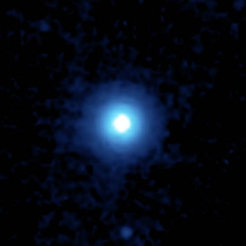
Vega ist he brightest star in the constellation Lyra (the harp) and one of the five brightest in the whole sky. Together with the two star Deneb in Cygnus (the swan) and Altair in Aquila (the eagle), Vega forms the “summer triangle” which can easily be identified in the summer sky.
From the Earth we have walked 25 light years (scaled 2.5 metres) and it takes another 24,975 light years (2.5 kilometres) to reach the centre of our Milky Way.
12) Antares
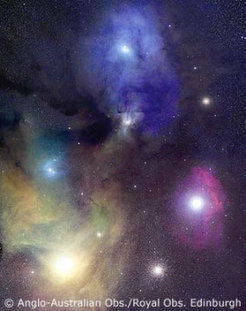
Antares in the constellation Scorpius (the scorpion) is similar to Betelgeuse a red supergiant star in a late stage of its evolution. It is 700 times larger in diameter than our sun. Even the orbit of Jupiter around the sun would completely fit within the gigantic size of that star.
From the Earth we have walked 520 light years (scaled 52 metres) and it takes another 24,480 light years (2.45 kilometres) to reach the centre of our Milky Way.
13) Dumbbell Nebula
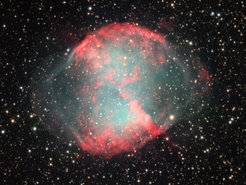
The Dumbbell Nebula (M27) is a planetary nebula in the constellation Vulpecula (the fox). That designation is not connected to planets, it is instead a very old central star (a so-called white dwarf) which has blown away its outer shell appearing as bright and colourful nebula. M27 can be seen with a pair of binoculars.
From the Earth we have walked 980 light years (scaled 98 metres) and it takes another 24,020 light years (2.4 kilometres) to reach the centre of our Milky Way.
14) Eagle Nebula
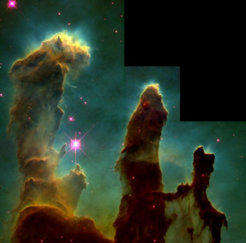
The Eagle Nebula (M16) is a star forming region in the constellation Serpens (the snake) which is well known because of a famous image taken with the Hubble Space Telescope. It shows towering dust clouds where new stars are being formed at the top.
From the Earth we have walked 7,000 light years (scaled 700 metres) and it takes another 18,000 light years (1.8 kilometres) to reach the centre of our Milky Way.
15) M22
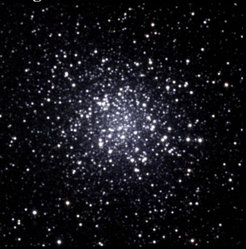
M22 in the constellation Sagittarius (the archer) is the brightest globular cluster visible in central Europe, consisting of more than a million single stars. It can be found in the night sky in summer in southern direction and is visible with the unaided eye.
From the Earth we have walked 10,000 light years (scaled 1 kilometre) and it takes another 15,000 light years (1.5 kilometres) to reach the centre of our Milky Way.
16) SN1604
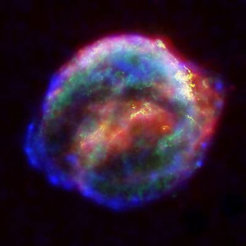
SN1604 is the remnant of a supernova in the constellation Ophiuchus (the serpent-bearer). The supernova in the sky was observed by Johannes Kepler in the year 1604; it showed up as bright as the planet Jupiter in the night sky. Today there is only weak nebulosity in the optical, but a strong radio source which can be observed with the 100 m radio telescope.
From the Earth we have walked 15,000 light years (scaled 1.5 kilometres) and it takes another 10,000 light years (1 kilometre) to reach the centre of our Milky Way.
17) W43

W43 is an extended star forming region (HII region) at the border between the constellations Scutum (the shield) and Aquila (the eagle), and is ten times larger in size than the well-known Orion Nebula (mini-starburst). Because of strong foreground absorption it is completely invisible in optical wavelengths, but shows up as strong radio source.
From the Earth we have walked 20,000 light years (scaled 2 kilometres) and it takes only 5,000 light years (500 metres) to reach the centre of our Milky Way.
18) Galactic Centre
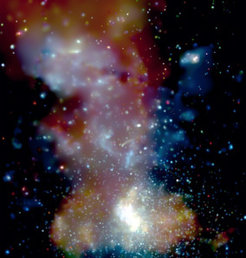
With the Galactic Centre we have reached our walking destination, 40,000 light years or 4 km from the start and 25,000 light years or 2.5 km from the Earth. The Galactic Centre region consists of a dense star cluster and also a supermassive black hole with more than four million times the mass of our sun. The Andromeda Galaxy (M31) the nearest large galaxy system, is at a distance of 2.5 million light years or 250 kilometres on the scale of the Milky Way Walk.
19) Andromeda Galaxy
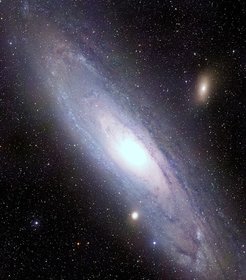
The Andromeda Galaxy (M31) ist the nearest large-size galaxy system in a distance of 2.5 million light years, corresponding to 250 kilometres on the scale of the Milky Way Walk. Station no. 19 of the walk can be found at the main entrance of the “Haus der Astronomie” (HDA) on Königstuhl mountain near Heidelberg which is in a distance of 247 kilometres from the Effelsberg Radio Observatory.
20) NGC 205

NGC 205 (also: M110) is a companion galaxy of the Andromeda nebula M31. The distance to M31 is 190,000 light-years, corresponding to 19 km in scale of the Milky Way Trail. The station NGC 205 is set up at the Planetarium Mannheim, at a linear distance of 19 km from the "Haus der Astronomie" (location of the Andromeda galaxy).
Picture Credits:
- The pictures of IC 410, Crab Nebula, Betelgeuse, S147, Sirius, Earth, Alpha Centauri, Dumbbell Nebula, Eagle Nebula, SN1604 and the Galactic Centre were taken from the archive of Astronomy Picture Of The Day (APOD, NASA).
- The Pleiades were taken from a Hubble Telescope project page, the Vega image is an infrared image taken by Spitzer Space Telescope, and the M22 infrared image was taken from the 2MASS catalogue.
- The image of Alpha Centauri originates from the European Southern Observatory (ESO).
- Antares and the Orion Nebula were taken by David Malin at the Anglo Australian Observatory.
- The radio image the star forming region W43 was observed with the Effelsberg 100-m telescope.
- The optical image of the Andromeda galaxy system (M31, M32, NGC 205) was taken at the Tautenburg Observatory.
The German version of this webpage was originally created by Svenja Gehrke, Sankt-Adelheid-Gymnasium, Bonn-Beuel, within the scope of a school work experience project at MPIfR. English translation by Norbert Junkes.
